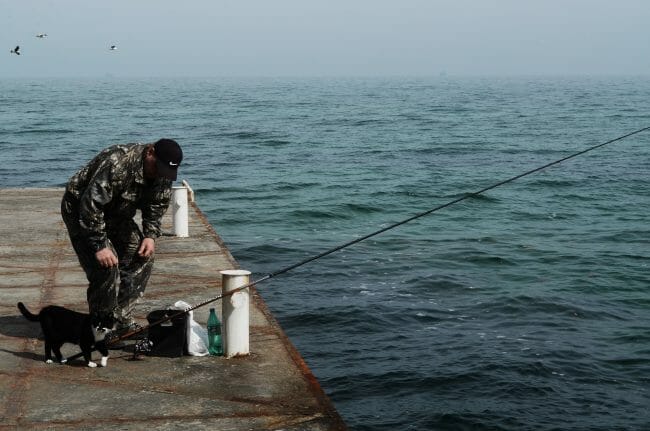If you are just starting out fishing on your local pier then you may be a little confused as to all of the advice you will get online about what kind of pier fishing rod setup you should use.
The number one thing to remember is that you need to match you rod to what you will be fishing for and just how exactly you’ll be doing it.
If your is to use small jigs then a big beefy rod is not going to give you the type of feedback that you will need.
And, conversely if you are targeting much bigger species that require and rod and reel setup with a lot of backbone then a lighter setup is virtually useless.
If you can have a chat with the local fishermen that are already fishing there. Some of them may well be fishing on that same pier all their life and their advice will be thoroughly invaluable when it comes to what kind of tackle you will need.
For the most part you reduce down the number of different setups to just three:
- Light – for jigging, catching baitfish and other smaller species
- Medium – for bait work and light lure casting
- Heavy – for large species and large lure casting work
However, if you are just starting out then I would recommend just one rod and reel as your first purchase.
A good pier fishing rod for a beginner would be roughly 7 feet in length and have a medium power rating. Paired with a spinning reel and 15 lb mono.
This is a fairly generic type of rod and reel that can over a lot of species and as ever with pier fishing it really does depend on your local pier and what type of fish you will target regularly.
3 Pier Fishing Rod Setups
1. Light Setup for Jigging/Baitfish
For catching smaller species and baitfish then you are going to need to use some light tackle.
When using light tackle I would always opt for a spinning rod and reel for pier fishing as they are better at handling lighter lines.
If you are doing a lot of finesse style jigging then you will need to have a lot of feedback from the jig back through the rod, you won’t get this kind of sensitivity with a heavy rod.
Graphite is usually preferred over a fiberglass rod when doing lighter work as again they will have much better tip sensitivity.
Aim for a 6’6″ to 7′ foot rod with a medium/light power rating and a fast action or a moderate/fast action.
You’ll need to pair a reel to that rod and a size 2000, 2500 or a 3000 depending on the rod and reel choice as each manufacturer is different.
You’ll need 10 lb monofilament or 20 lb braid. Mono has a bit more stretch in it but is better suited to beginners. Braid on the other hand has very little stretch which is great for jigging but it can result in wind knots.
2. Medium Setup for Bait/Lure work
A good medium setup could easily end up being your most used out of all three. When you are targeting fish in the 5 to 10lb range then a good choice is still a spinning rod.
Aim for between 7 and 8 feet in length and a medium/heavy power rating.
That extra length gives you both the ability to cast longer distances and also can help to steer fish away from the pylons beneath the pier which is usually their natural reaction once hooked.
Spinning reel of 3000 or 4000 and you can load that with 12 to 15 pound mono or up to 30 lb braid.
3. Heavy Setup for Larger Species and Heavy Lure Work
Bigger species mean bigger stronger tackle especially if you are using large sinkers or casting bigger lures.
If you are not looking to cast any great distance then you can use a spinning rod with a heavy power rating or roughly 9 feet in length.
If you are targeting really big fish like sharks then a conventional rod and reel is the better choice.
A conventional reel gives you a lot more cranking power.
They can also handle a lot more heavy braid than a spinning reel. Low profile baitcasters are rarely used as the casting distances are normally shorter than if you were doing a lot of heavy lure work looking to cover a lot of open water.

